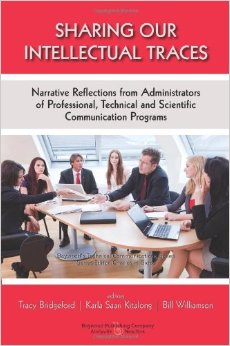By Caitlin Dungan
Caitlin Dungan is a PhD student in Mason’s Writing and Rhetoric PhD Program. Caitlin is a Graduate Research Assistant for Mason’s Writing Across the Curriculum Program, and her current research interests include fanfiction, digital media and rhetoric, online feedback practices, and participatory culture.
Sharing our Intellectual Traces: Narrative Reflections from Administrators of Professional, Technical and Scientific Communication Programs, eds. Tracy Bridgeford, Karla Saari Kitalong, Bill Williamson (Amityville, NY: Baywood Publishing, 2014).
Sharing our Intellectual Traces walks a mediatory line between the worlds of technical and professional communication, pedagogy, writing program administration, and writing across the curriculum. Though it may seem difficult to weave these related yet disparate areas together, the unique lenses through which this collection views these fields – narrative and administration – are the key to the success of its message and to its utility. The narrative nature of this collection offers perspectives about complicated institutional dynamics in a manner that is relatable and illuminating.


